Inside This Week’s Bull Bear Report
- Is There A Market Bubble?
- How We Are Trading It
- Research Report –Household Allocations Suggest Caution
- Youtube – Before The Bell
- Market Statistics
- Stock Screens
- Portfolio Trades This Week
The Fed’s Non-Event Event
Last week, we suggested we could see a further correction this week, given some of the weaknesses that had been accruing. Such was the case until Wednesday’s FOMC meeting announcement. While the meeting was largely as expected, with no real change to outlook, the outcome was seen as primarily “dovish” as Powell reaffirmed the Fed was still on track to cut rates three times this year.
“While The Fed kept its median dot at 3 cuts for 2024, beyond that the dots signal considerably less aggressive Fed rate-cutting. We also note that while the median 2024 dot remained the same, 8 Fed voters were for 50bps or less in Dec, now it’s 9. The Fed now expects one less rate-cut in 2025 and 2026… and the so-called ‘neutral’ rate has also been increased.“ – Zerohedge
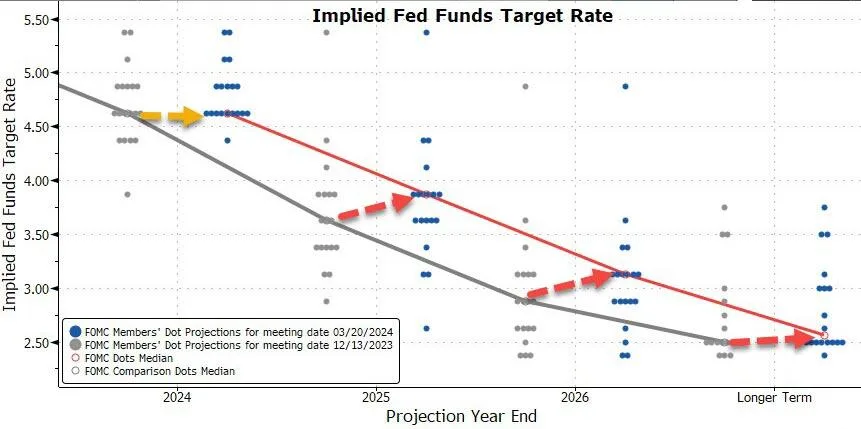
With financial conditions now as loose as they were before the Fed started hiking rates, the markets remain unmoved by slightly more hawkish rhetoric.
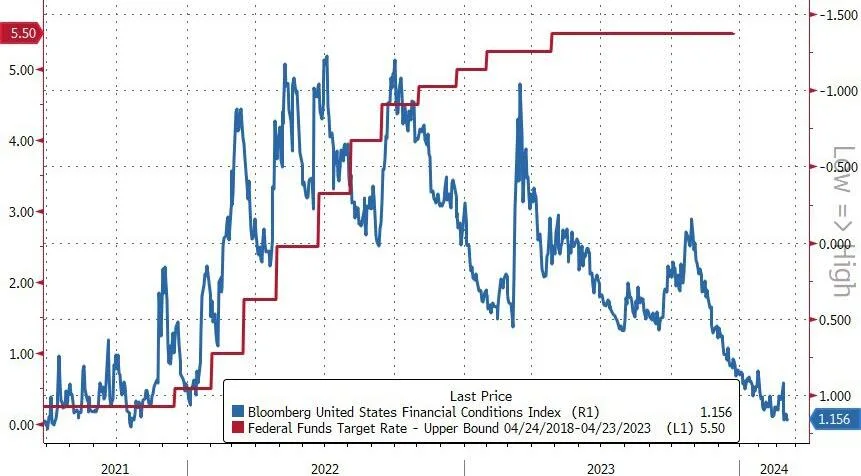
With that announcement, the market surged to an all-time high, reversing the recent momentum weakness. The market remains in a nearly perfect trend that only Bernie Madoff could have designed. As we have repeated, to the point of “ad nauseam,” over the last several weeks, the market remains confined to a very defined channel. The 20-DMA continues as critical support where computer algorithms continue to “buy dips,” and sellers resurface at the channel’s top.
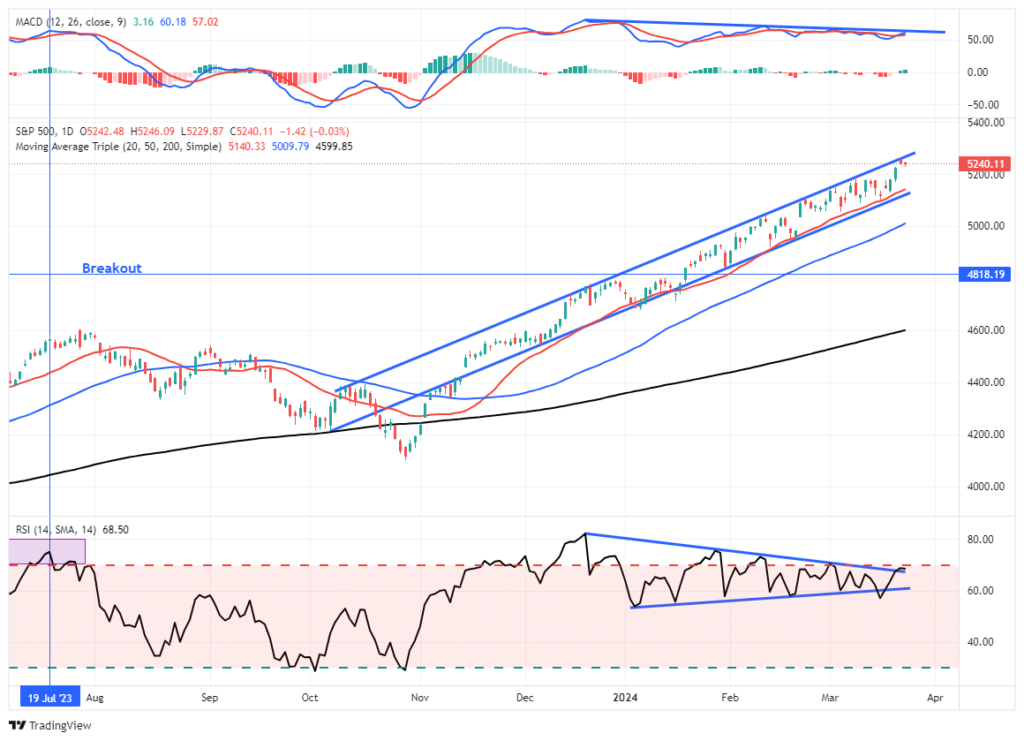
For now, this mind-numbingly narrow channel, with extremely low volatility and high complacency, remains. What will change that dynamic? I have no idea. As shown, volatility continues to plumb the “nether regions” as investor optimism surges.
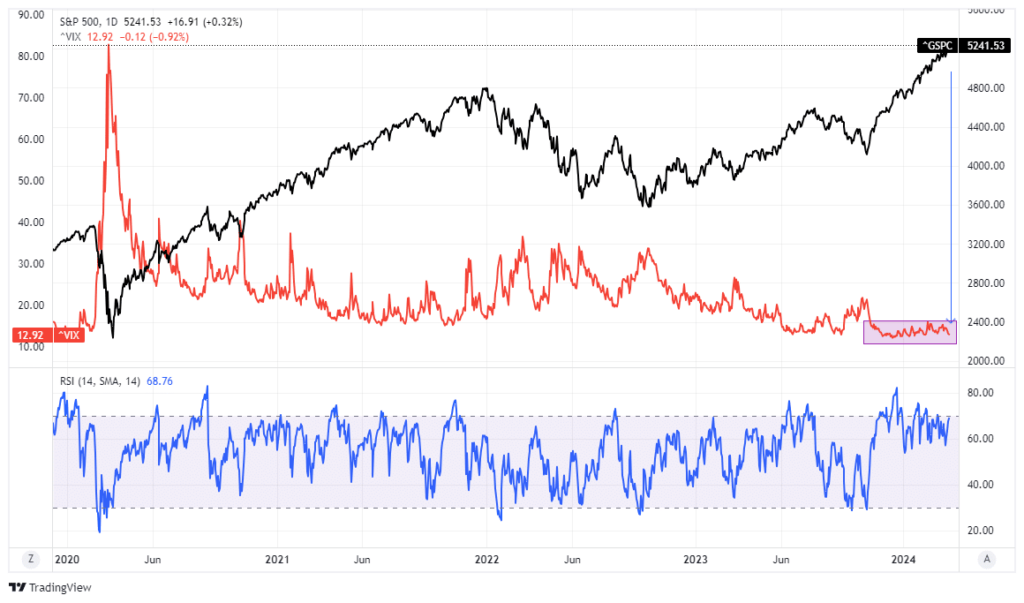
However, as is always the case, at some point, this will reverse itself. What triggers it is unknown, but a good warning sign will be a violation of the 20-DMA. As noted, we suspect such a violation will trip the algorithms into “sell” mode and increase downside price pressures. The problem for investors is that this bullish trend has already lasted much longer than expected and could continue. Therefore, we must maintain our current positioning and remain vigilant for a break of the trend channel to take more aggressive risk reduction actions.
As they say at amusement parks, “Make sure your seat belts are fastened securely and enjoy the ride.”
Need Help With Your Investing Strategy?
Are you looking for complete financial, insurance, and estate planning? Need a risk-managed portfolio management strategy to grow and protect your savings? Whatever your needs are, we are here to help.

What Is A Market Bubble?
Two weeks ago, we discussed whether the current market period was more indicative of a short-term top or a market bubble. Unsurprisingly, that article generated some debate on what defines a market bubble. This week, I thought we would tackle that definition.
According to Investopedia:
“A market bubble is a cycle that is characterized by the rapid escalation of market value, particularly in the price of assets. Typically, what creates a market bubble is a surge in asset prices driven by exuberant market behavior. During a market bubble, assets typically trade at a price that greatly exceeds the asset’s intrinsic value. Rather, the price does not align with the fundamentals of the asset.“
This definition is suitable for our discussion. There are three components of a “market bubble.” The first two, price and valuation, often get dismissed or rationalized during the inflation phase. That rationalization is due to investor psychology and the “Fear Of Missing Out (F.O.M.O.) Just recently, Bank of America posted the following chart of previous market bubbles in various asset classes, from gold to bitcoin.
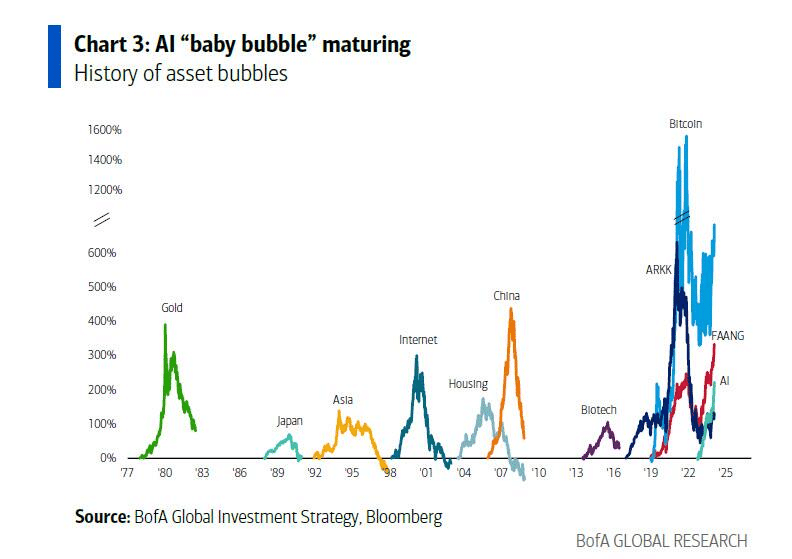
As the following table shows, market bubbles are not new but rather the maturity of a secular market cycle.

During these historical market bubbles, the common belief was that “this time is different.” Each period was marked by some industrial, economic, financial, or technological change that broke prior market relationships. Interestingly, Goldman Sachs recently made the same assumption, to wit:
“The recent rally has driven the market cap share in stocks with extremely high valuations to levels similar to those reached during the euphoria of 2021.
However, the prevalence of extreme valuations today looks far less widespread than in 2021 after adjusting for market concentration. The number of stocks with elevated EV/sales ratios has declined sharply from the peak in 2021. Unlike the broad-based “growth at any cost” in 2021, investors mostly pay high valuations for the largest growth stocks in the index. This dynamic more closely resembles the Tech Bubble than 2021. However, in contrast with the late ’90s, we believe their fundamentals currently support the valuation of the Magnificent 7.“
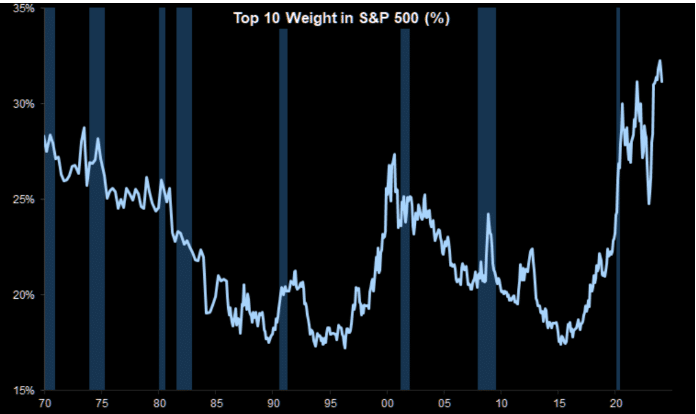
What is essential to understand, and what is ultimately always overlooked, is that market bubbles are nothing more than a representation of investor psychology.
Market Bubbles Are All About Psychology
As Jeremy Grantham previously noted:
“All 2-sigma equity bubbles in developed countries have broken back to trend. But before they did, a handful went on to become superbubbles of 3-sigma or greater: in the U.S. in 1929 and 2000 and in Japan in 1989. There were also superbubbles in housing in the U.S. in 2006 and Japan in 1989. All five of these superbubbles corrected all the way back to trend with much greater and longer pain than average.
Today in the U.S. we are in the fourth superbubble of the last hundred years.”
Are we currently in a market bubble? Maybe. Honestly, I have no idea. The problem is that market bubbles are only evident and acknowledged after they pop. This is because, during the inflation phase of the market bubble, investors rationalize why “this time is different.”
As noted above, there are three components of market bubbles:
- Price
- Valuations
- Investor Psychology
When investors bid up asset prices that exceed underlying earnings growth rates, market bubbles have previously been present. The reason is that since economic activity generates revenues and earnings, valuations can not indefinitely exceed the underlying fundamental realities. Since valuations are a function of price and earnings, deviations of the market from the long-term exponential growth trend have marked prior peaks.
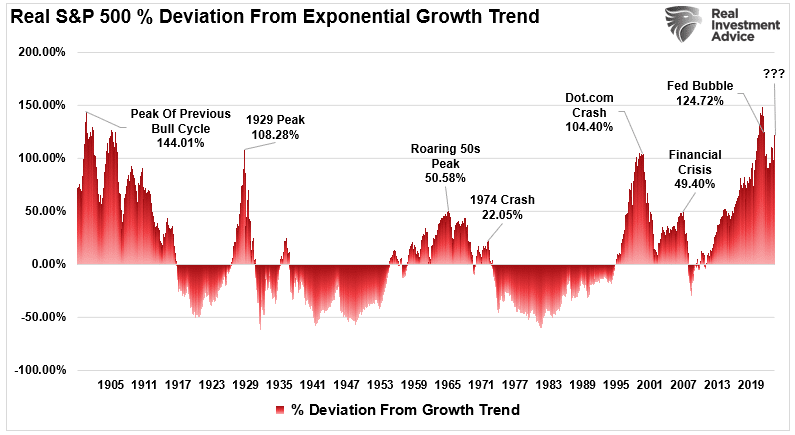
Unsurprisingly, when price momentum increases rapidly, investors rationalize why overpaying for earnings is justified this time. Unfortunately, as shown, such has rarely worked out well.
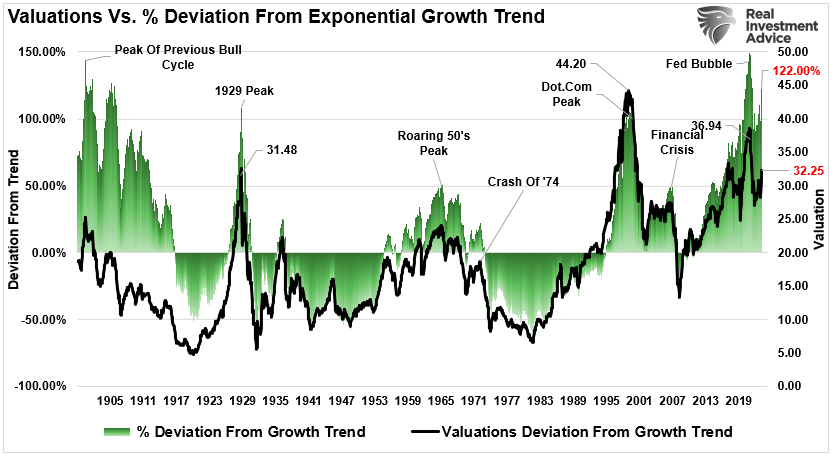
As the chart shows, and the definition of a market bubble states, “assets typically trade at a price that significantly exceeds the asset’s intrinsic value. Instead, the price does not align with the fundamentals of the asset. “
Crucially, excess valuations and price deviations from long-term norms are solely a function of investor psychology.
Valuation metrics are just that – a measure of current valuation. More importantly, when valuation metrics are excessive, it is a better measure of “investor psychology” and the manifestation of the “greater fool theory.” As shown, there is a high correlation between our composite consumer confidence index and trailing 1-year S&P 500 valuations.
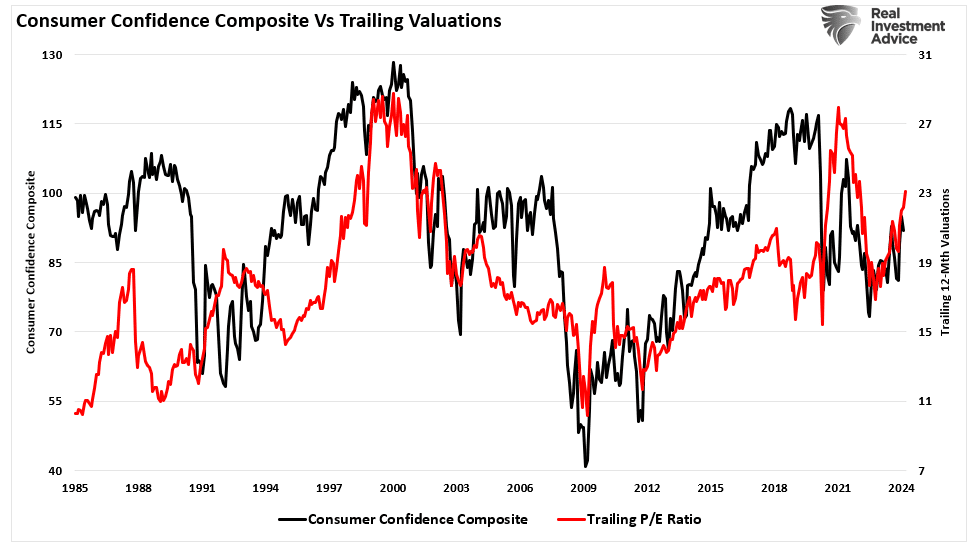
What valuations do provide is a reasonable estimate of long-term investment returns. It is logical that if you overpay for a stream of future cash flows today, your future return will be low.
Measures Of Psychology Suggest Caution
So, if market bubbles are a function of investor psychology, we should focus on those measures to determine the risk to our portfolios. One of my favorite quotes on this subject comes from Howard Marks, the investing legend from Oaktree Capital Management. To wit:
“It’s the swings of psychology that get people into the biggest trouble, especially since investors’ emotions invariably swing in the wrong direction at the wrong time. When things are going well people become greedy and enthusiastic, and when times are troubled, people become fearful and reticent. That’s just the wrong thing to do. It’s important to control fear and greed.“
As discussed last week, investor allocations to equities are rising sharply as chasing asset market returns displaces logic and underlying fundamentals.
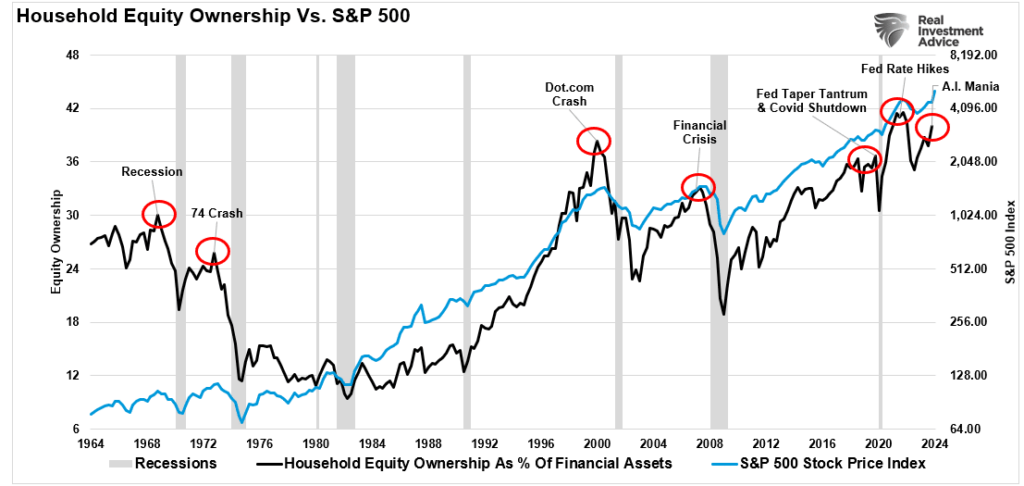
The American Association Of Individual Investors (AAII) allocation measures suggest the same, with investors increasing exposure to equities and reducing cash.
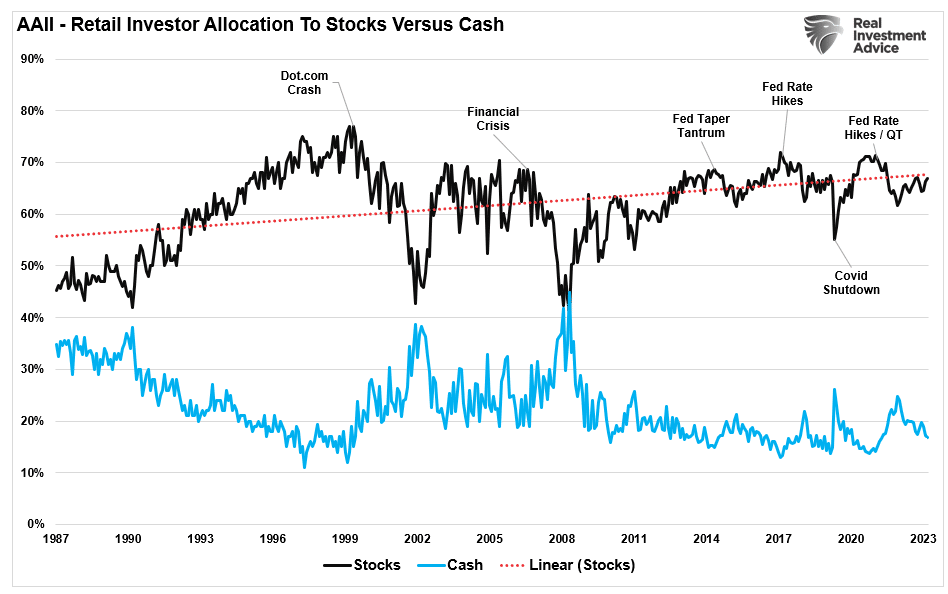
Also, the National Association of Investment Managers index shows that professional managers are 104% long equities in their portfolios. Such previous periods of exuberance have been more akin to market peaks than ongoing bull markets.
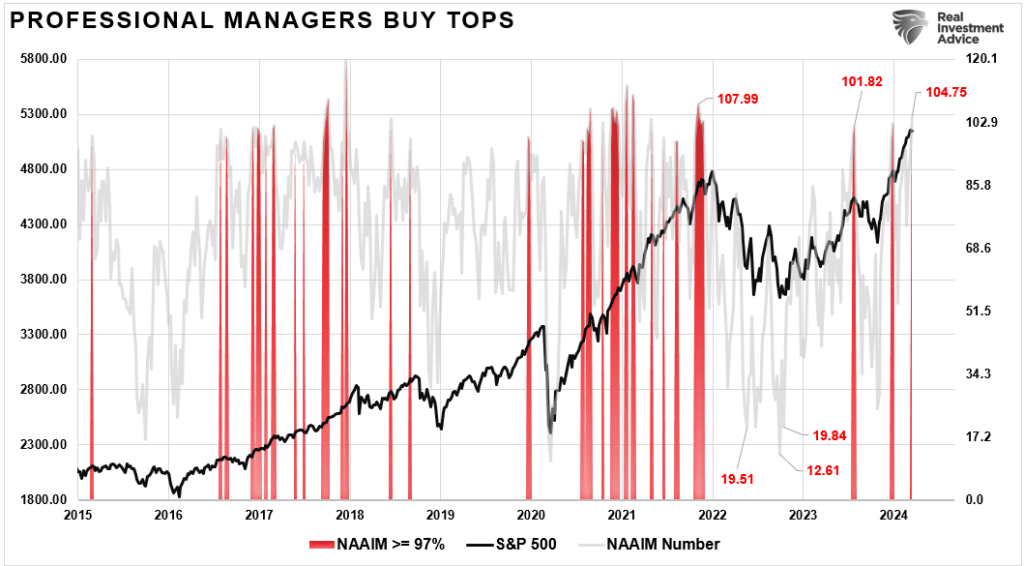
Aside from actual portfolio allocations, the best investor sentiment indicators are professional and retail investors, who are about as bullish as possible.

Does this mean we are in a market bubble currently? No. However, as Howard Marks previously noted:
“We can infer psychology from investor behavior. That allows us to understand how risky the market is, even though the direction in which it will head can never be known for certain. By understanding what’s going on, we can infer the ‘temperature’ of the market.
We must remember to buy more when attitudes toward the market are cool and less when heated. For example, the ability to do inherently unsafe deals in quantity suggests a dearth of skepticism among investors. Likewise, when every new fund is oversubscribed, you know there’s eagerness.“
Currently, there is little denying the more excessive bullish sentiment that abounds. Investors are willing to take on risk, overpay for underlying valuations, and rationalize their actions. Historically, these actions have been the precedents of every previous market bubble.
As Mark Hulbert once noted:
‘I have no idea whether the stock market is actually forming a bubble that’s about to break. But I do know that many bulls are fooling themselves when they think a bubble can’t happen when there is such widespread concern. In fact, one of the distinguishing characteristics of a bubble is just that.”
I agree with that sentiment.
Conclusion
Whether you agree a bubble exists is mainly irrelevant. Every investor approaches investing differently.
However, if you’re nearing or are a retiree, your investment horizon is shorter than those much younger. Therefore, given you are less able to recover from the deflation of a market bubble, it may be wise to consider the possibility.
So, what can you do to navigate the bubble?
- Avoid the “herd mentality” of paying increasingly higher prices without sound reasoning.
- Do your research and avoid “confirmation bias.”
- Develop a sound long-term investment strategy that includes “risk management” protocols.
- Diversify your portfolio allocation model to include “safer assets.”
- Control your “greed” and resist the temptation to “get rich quick” in speculative investments.
- Resist getting caught up in “what could have been” or “anchoring” to a past value. Such leads to emotional mistakes.
- Realize that price inflation does not last forever. The larger the deviation from the mean, the greater the eventual reversion. Invest accordingly.
The increase in speculative risks and excess leverage leaves the market vulnerable to a sizable correction. Unfortunately, the only missing ingredient is the catalyst that brings “fear” into an overly complacent marketplace.
Currently, investors believe “this time IS different.”
“This time” is different only because the variables are different. The variables always are, but outcomes are always the same.
When the bubble pops, the media will tell you, “No one could have seen it coming.”
Of course, hindsight isn’t very useful in protecting your capital.

Have a great week.
Research Report
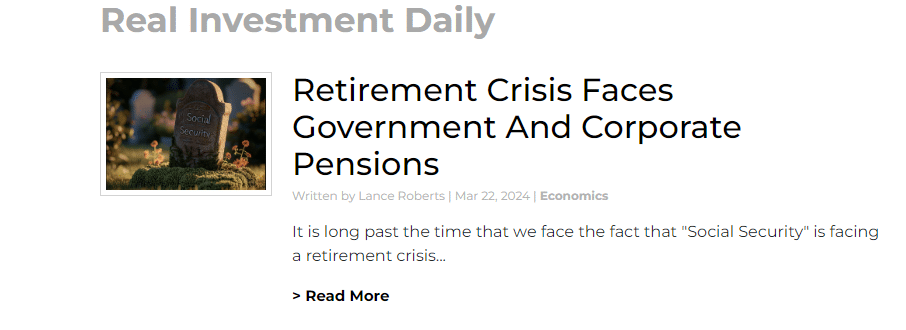
Subscribe To “Before The Bell” For Daily Trading Updates
We have set up a separate channel JUST for our short daily market updates. Please subscribe to THIS CHANNEL to receive daily notifications before the market opens.
Click Here And Then Click The SUBSCRIBE Button
Subscribe To Our YouTube Channel To Get Notified Of All Our Videos
Bull Bear Report Market Statistics & Screens

SimpleVisor Top & Bottom Performers By Sector
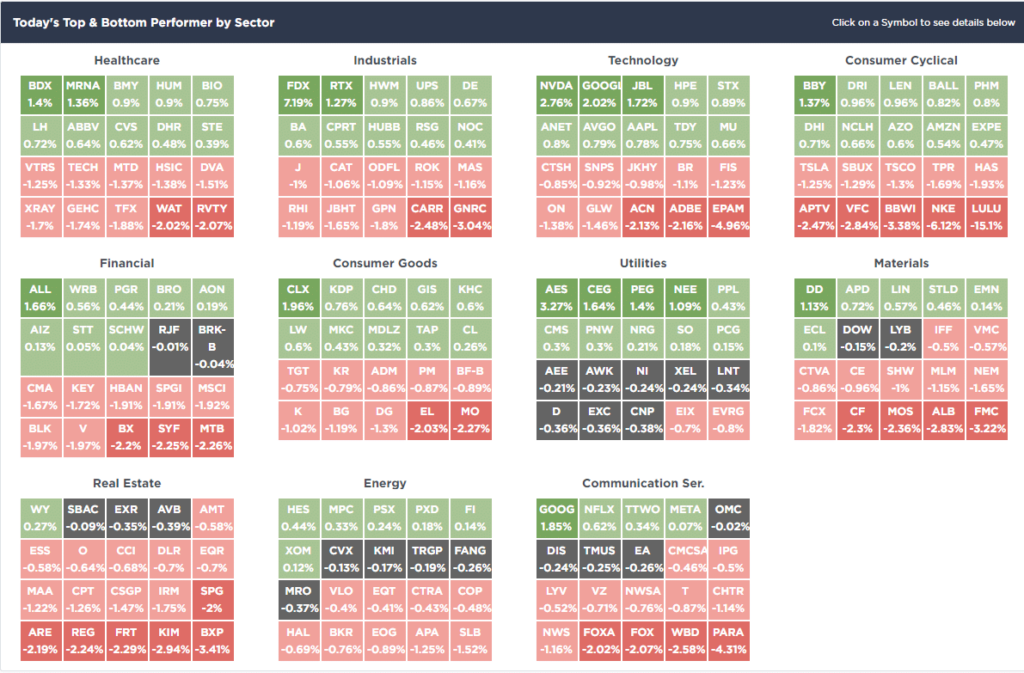
S&P 500 Weekly Tear Sheet
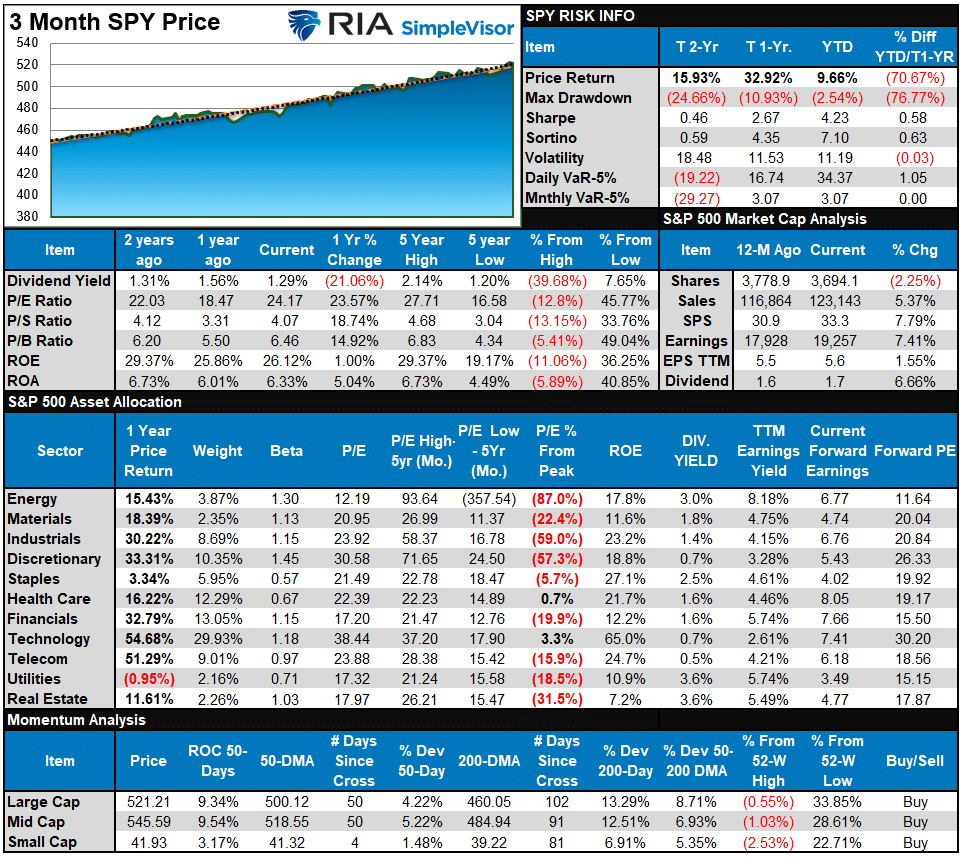
Relative Performance Analysis
Following the FOMC meeting, the market surged to new highs but remained within the ongoing bullish trend channel. The good news is that performance has broadened slightly, with more sectors outperforming the index for the year. There is little need for overly cautious measures, but a continued risk management process is suggested. The bullish backdrop of the market continues to improve as fears of a recessionary episode fade.
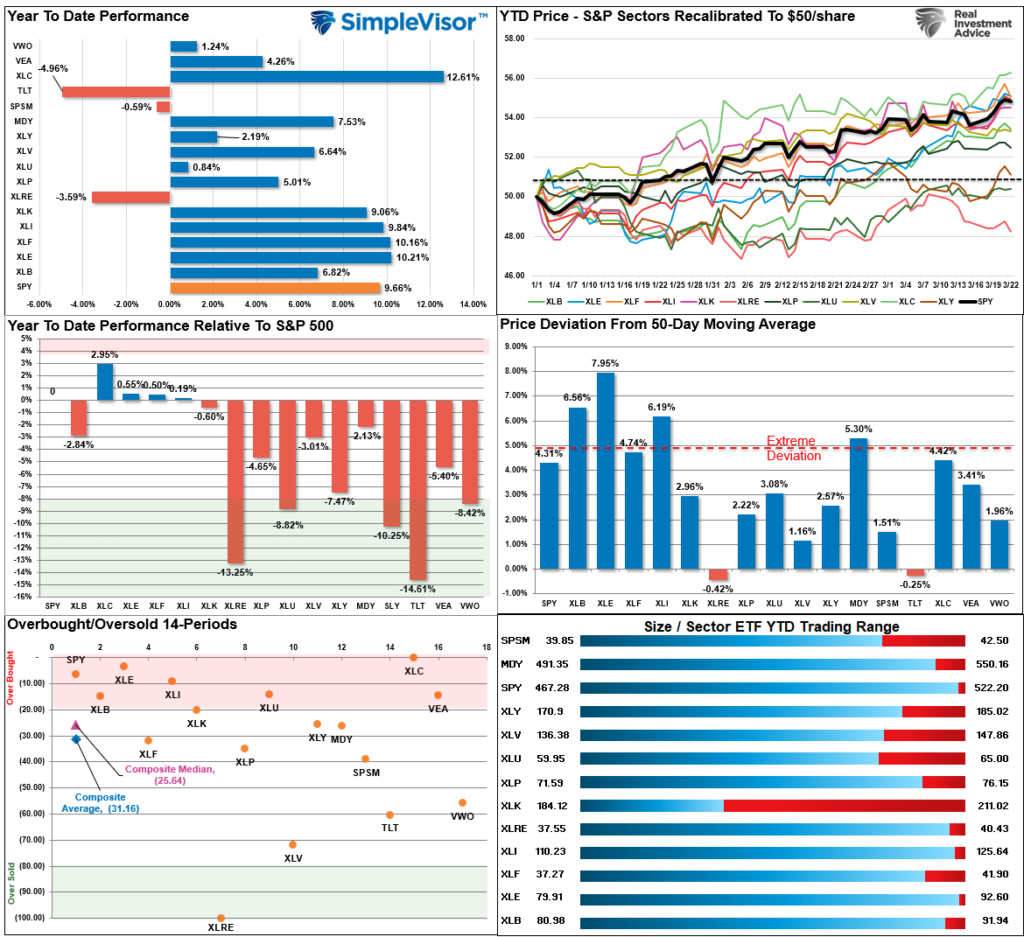
Technical Composite
The technical overbought/sold gauge comprises several price indicators (R.S.I., Williams %R, etc.), measured using “weekly” closing price data. Readings above “80” are considered overbought, and below “20” are oversold. The market peaks when those readings are 80 or above, suggesting prudent profit-taking and risk management. The best buying opportunities exist when those readings are 20 or below.
The current reading is 94.74 out of a possible 100.

Portfolio Positioning “Fear / Greed” Gauge
The “Fear/Greed” gauge is how individual and professional investors are “positioning” themselves in the market based on their equity exposure. From a contrarian position, the higher the allocation to equities, the more likely the market is closer to a correction than not. The gauge uses weekly closing data.
NOTE: The Fear/Greed Index measures risk from 0 to 100. It is a rarity that it reaches levels above 90. The current reading is 86.28 out of a possible 100.
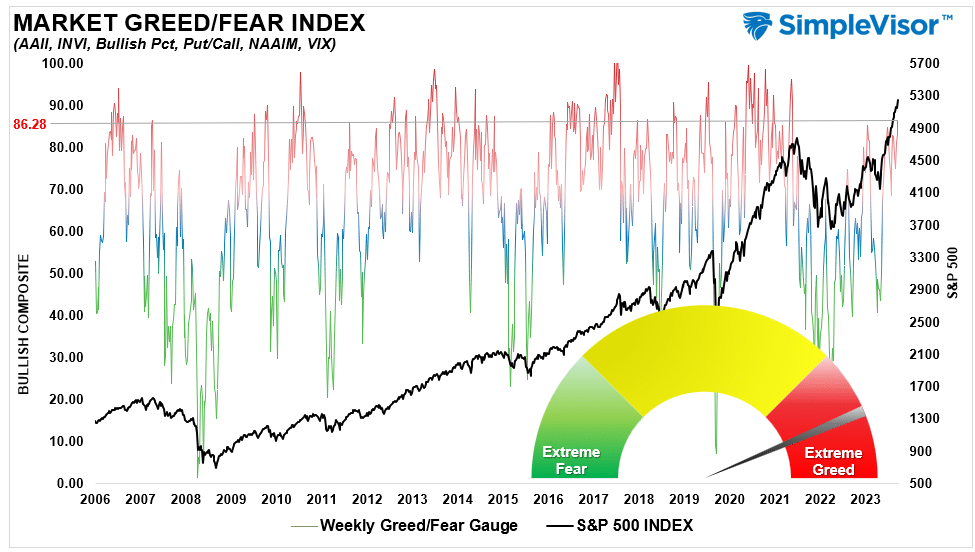
Relative Sector Analysis
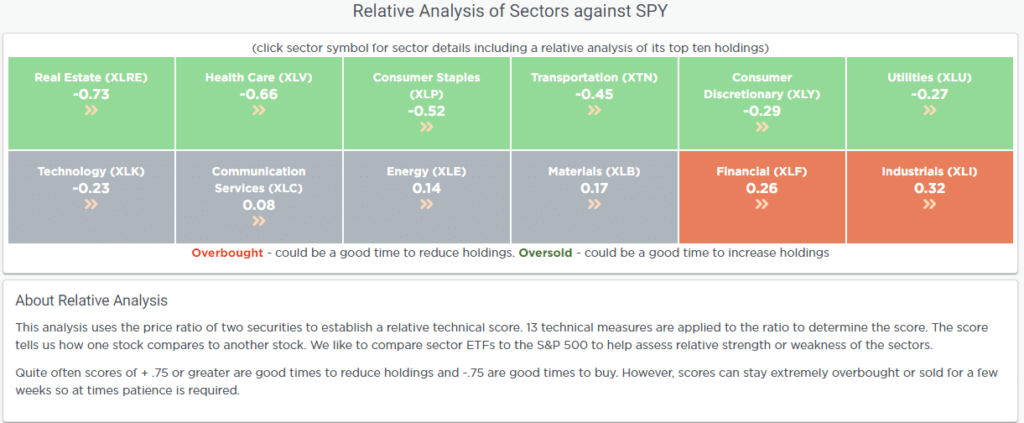
Most Oversold Sector Analysis
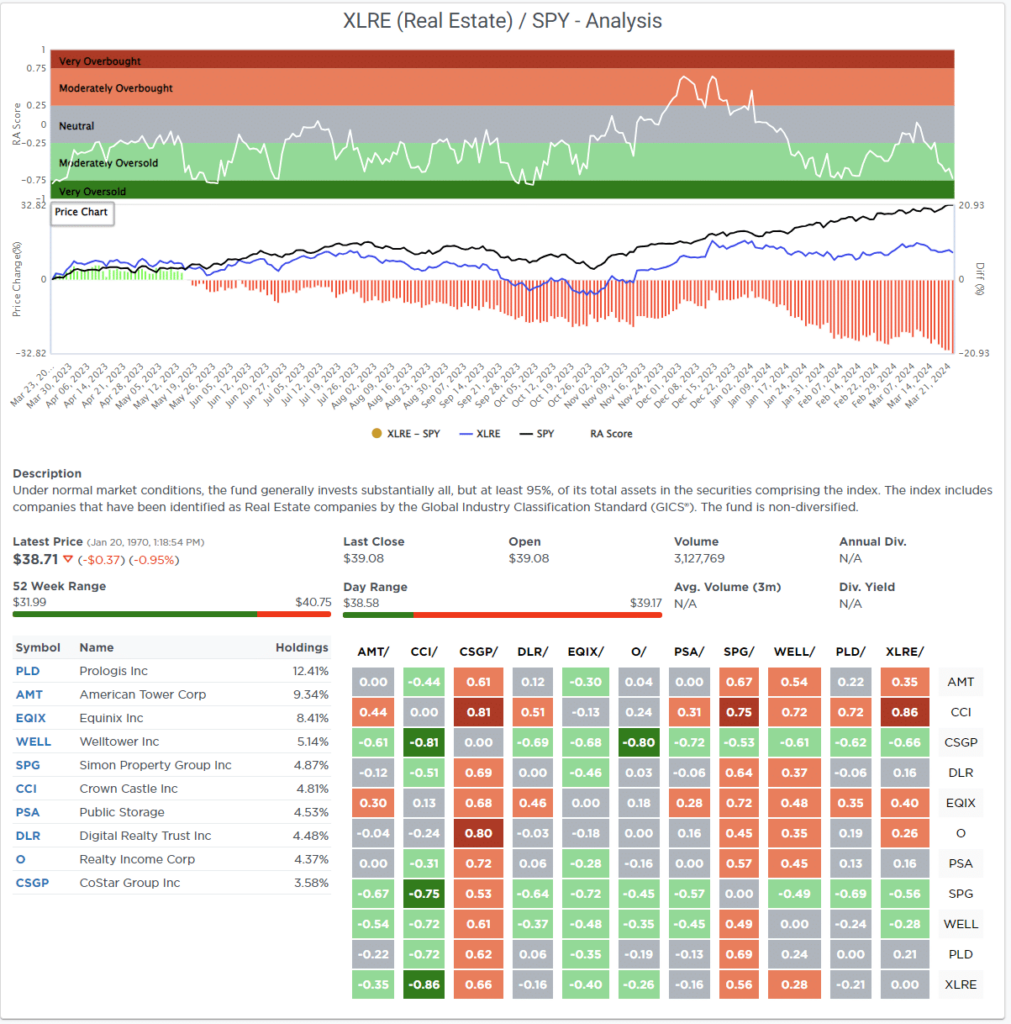
Sector Model Analysis & Risk Ranges
How To Read This Table
- The table compares the relative performance of each sector and market to the S&P 500 index.
- “MA XVER” (Moving Average Crossover) is determined by the short-term weekly moving average crossing positively or negatively with the long-term weekly moving average.
- The risk range is a function of the month-end closing price and the “beta” of the sector or market. (Ranges reset on the 1st of each month)
- The table shows the price deviation above and below the weekly moving averages.
Deviations for many market sectors from their longer-term moving averages remain extreme. Gold, Gold Miners, Energy, and Materials are well outside their normal risk ranges as well, suggesting profit-taking should be implemented. The bullish backdrop of the market remains, but at some point, there will be a correction that reverses these more extreme deviations. However, corrections will be mild and buyable opportunities with most sectors and markets trading with bullish moving average crossovers.
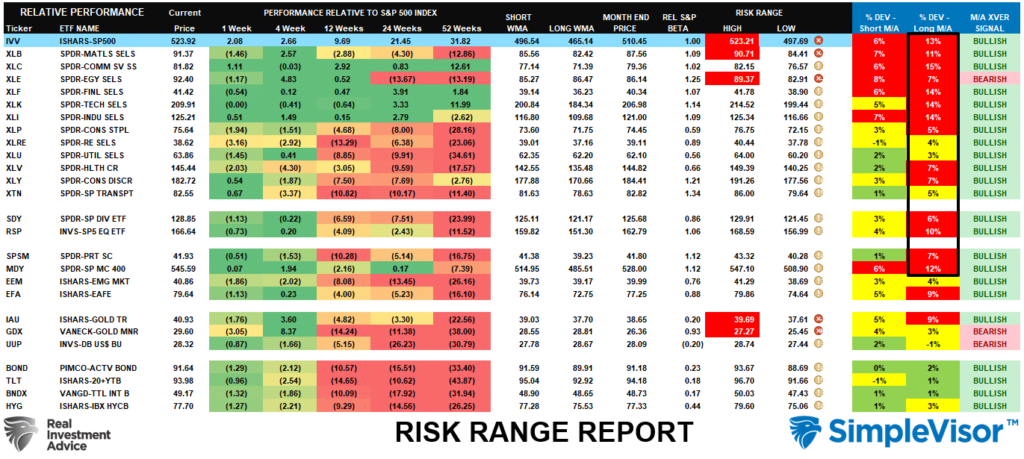
Weekly SimpleVisor Stock Screens
We provide three stock screens each week from SimpleVisor.
This week, we are searching for the Top 20:
- Relative Strength Stocks
- Momentum Stocks
- Fundamental & Technical Strength W/ Dividends
(Click Images To Enlarge)
R.S.I. Screen
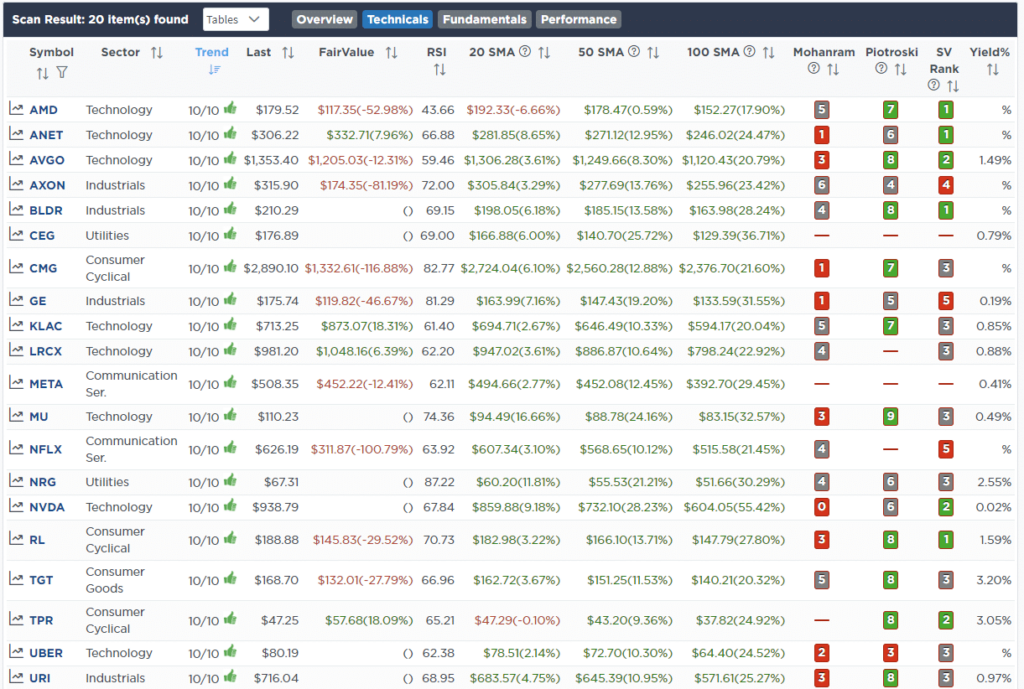
Momentum Screen
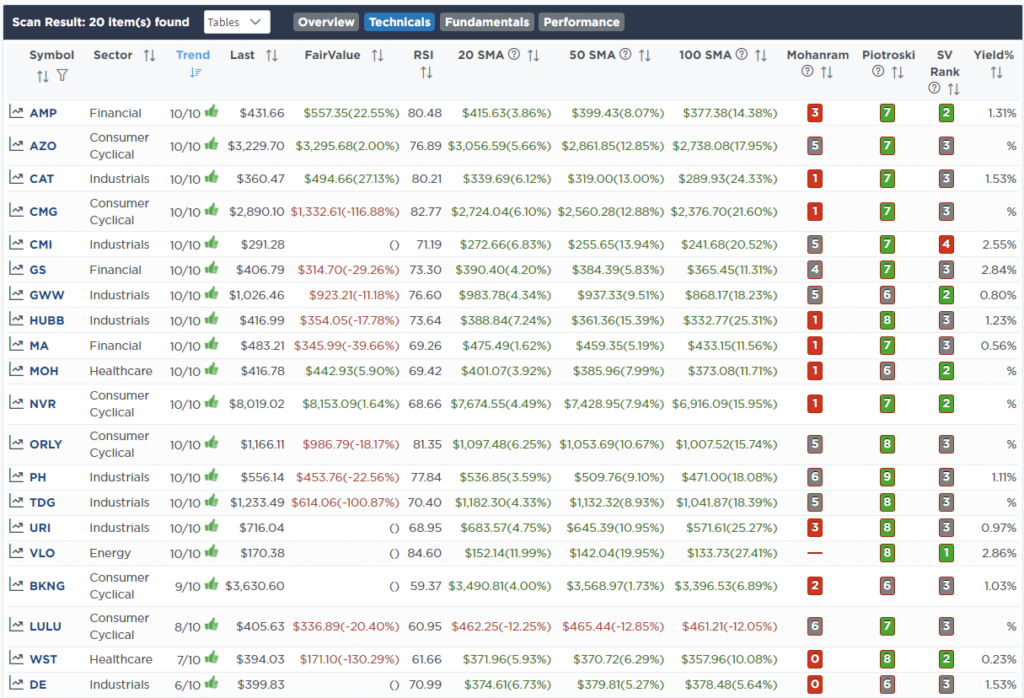
Fundamental & Technical Strength

SimpleVisor Portfolio Changes
We post all of our portfolio changes as they occur at SimpleVisor:
No Trades This Week

Lance Roberts, C.I.O.
Have a great week!


